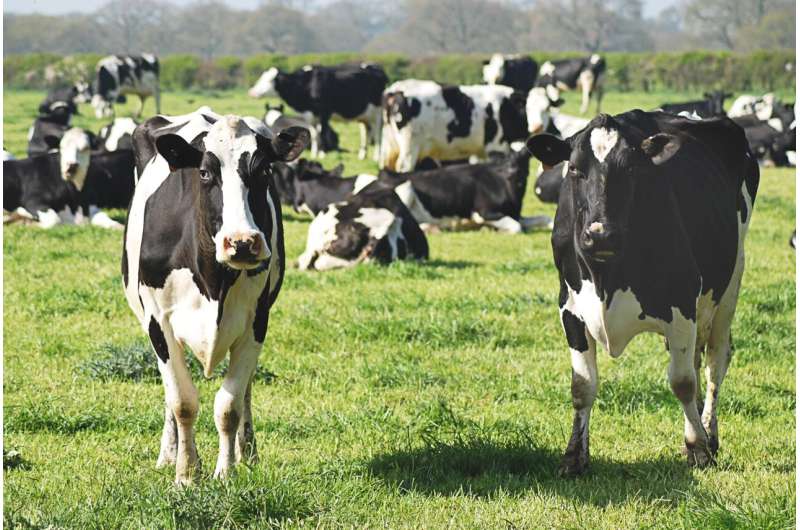Scientists' win-win solutions to global nitrogen crisis are good for the pocket and planet

The most comprehensive scientific review of the global nitrogen cycle has outlined 150 "win-win" measures to significantly reduce nitrogen pollution while saving billions in costs across a range of industries.
The solutions have been put forward by a team of 50 international experts, led by the UK Centre for Ecology & Hydrology (UKCEH), in a new for the United Nations. They aim to address the problem of excessive nitrogen leakage that is damaging our oceans, lakes, air and soils, while improving food security and reducing costs for business.
Nitrogen, an essential nutrient for life, is present in human and animal excreta and synthetic fertilizers, as well as being a byproduct of fuel combustion processes. However, inefficient management in sectors such as agriculture, transport, wastewater treatment and aquaculture, means around 80% of reactive nitrogen resources escape into the environment.
Nitrogen in its various forms—including ammonia, nitrogen oxides, nitrate and nitrous oxide—can result in poor air quality that threatens human health, toxic algal blooms that cause the death of plants and fish in oceans and lakes, and increased climate change.
Providing a toolkit
The new international guidance document goes beyond agriculture, which is the largest consumer and emitter of nitrogen, to consider all economic sectors, and addresses the issue on a global scale.
The authors have also produced an online toolkit, the , which is designed to be used alongside the guidance document and provides further detail on each measure, including "how to implement," and the cost, benefits and risks of implementing each measure. This will support policymakers and stakeholders to select the most suitable measures for their specific requirements and ambitions.
The international guidance document considers synergies and trade-offs between actions and features case studies to demonstrate how a package of measures can be selected.
Key recommendations
The recommended actions include:
- Improved fertilizer use. More efficient storage and application of organic and synthetic fertilizers, which would reduce pollution, energy consumption and costs for farmers.
- Sustainable farming practices. Using cover crops and reducing tillage to retain nitrogen in soils. Integrating livestock and arable farming where possible. Keeping animal housing clean.
- Natural filtration systems. Constructing wetlands to keep nitrogen pollution out of lakes and rivers.
- Nitrogen recovery. Improving treatment of sewage and food waste to recover nitrogen, which can then be added as a fertilizer to fields.
- Sustainable fish farming. Applying nutrient-rich sludge from fish farms to agricultural land as a fertilizer using low-emission techniques.
- Reducing transport emissions. Increasing the use of electric vehicles and improving fuel combustion processes, and recovering nitrogen oxides for their nitrogen value.
- Dietary changes. Cutting food waste and consumption of animal products with high nitrogen footprints.
- Energy generation from organic residues. Using anaerobic digestion to process manure and aquaculture sludge into biogas, with the byproducts retained for use as fertilizer.
The cost of nitrogen waste
Scientists estimate 200 billion tons of nitrogen is lost to the environment globally every year, which--if equated with the wastage of the same amount of fertilizer--is equivalent to a loss of up to 300 billion US dollars at current prices.
Benefits for people and the planet
Dr. Will Brownlie, lead author of the report, says, "Improving nitrogen management offers a remarkable opportunity to not only enhance environmental health but also strengthen the global economy. The key lies in adopting an integrated approach across the entire nitrogen cycle, ensuring that all sectors involved have access to the diverse strategies available to improve nitrogen sustainability."
The guidance document, produced by scientists representing 40 institutes in 21 countries, points out that sustainable nitrogen management is crucial to achieving most of the UN Sustainable Development Goals.
Retaining more nitrogen within the agricultural system would improve food security, especially in regions where nutrient-poor soils limit crop production.
Sustainable management of nitrogen would also help mitigate climate change, by reducing nitrous oxide emissions.
Circular economy
The report advocates using data collection, satellite monitoring and artificial intelligence, combined with smartphone technologies, to provide accurate, site-specific nitrogen management guidance.
Professor Mark Sutton of UKCEH, who leads the International Nitrogen Management System (INMS), emphasizes, "We are delivering innovative science-based guidance for the UN to accelerate uptake globally. Our vision is for a circular nitrogen economy that wastes less of this precious resource, reducing the costs to governments, farmers and wastewater companies, while boosting farmers' incomes."
Isabelle van der Beck of the United Nations Environment Programme (UNEP), adds, "INMS is highlighting the importance of nitrogen as a multi-dimensional challenge that links all economic sectors. We see this as a way to mobilize efforts to reduce international water pollution, so we can simultaneously benefit air, climate, biodiversity and the economy."
More information: W. J. Brownlie et al, Nitrogen Mitigation. INMS Guidance Document on Measures for Sustainable Nitrogen Management (2024).
Provided by UK Centre for Ecology & Hydrology





















